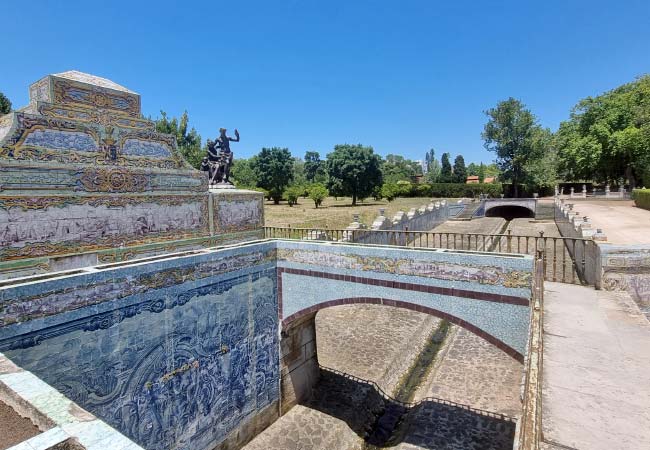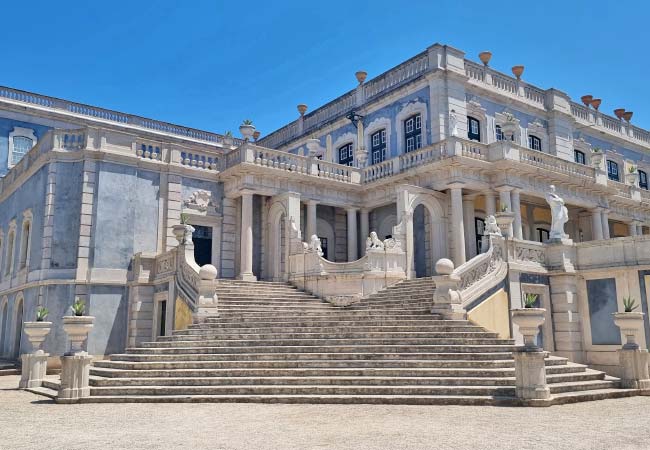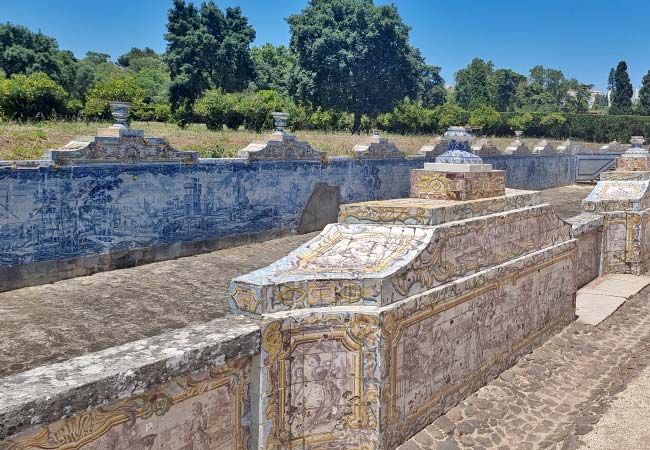Sintra-Portugal.com
The best independent guide to Sintra
Sintra-Portugal.com
The best independent guide to Sintra
Palácio de Queluz: an independent tourism guide for 2025
For much of its life, one of Portugal's most exuberant palaces was known as little more than a glittering stage for courtly pleasure. Conceived in the 18th century, the Palácio de Queluz was an intimate world of music, grand festivals, and garden parties.
But when the royal family fled the country in 1807, the music stopped. It slowly fell from favour with subsequent monarchs, and the magnificent, mirrored halls fell silent, a world of gilded fantasy left frozen in time. A devastating fire in 1934 nearly sealed its fate, threatening to destroy its opulent interiors forever.
Instead, the fire became the catalyst for its meticulous rebirth and restoration. When its doors were finally opened to the public, they revealed a flawless time capsule of Rococo artistry. Visitors can now step inside this world of gilded grandeur but also uncover the profound personal tragedy of Queen Maria I, for whom this palace of pleasure became her prison.
Highlights of the Palácio de Queluz
The Throne Room (Sala do Trono): The palace's gilded centrepiece. This is the largest and most magnificent hall, designed by Jean-Baptiste Robillion for grand parties and state banquets. Its walls are a spectacle of carved gilded wood and enormous mirrors, all designed to sparkle under crystal chandeliers.

The Ambassadors' Room (Sala dos Embaixadores): The room of formal audiences, where King João VI held hand-kissing ceremonies for nobility and foreign ambassadors. The ceiling painting depicts the royal family attending a concert, a reminder of the room's original purpose.

The Tiled Canal (Canal dos Azulejos): The garden's most spectacular and unique feature. This 115-meter-long canal could be flooded with water, allowing the royal court to take gondola rides. Its walls are lined with magnificent azulejo (ceramic tile) panels depicting seascapes and courtly scenes.

The Don Quixote Room (Quarto de Dom Quixote): A unique, circular-looking room that holds a poignant dynastic story. It is a space that encapsulates a perfect cycle of life and death: it was here that King Pedro IV was born, and 35 years later, it was in this very same room that he died.

Palácio de Queluz Tourist Information
The grounds are open daily from 09:00 to 18:30, and the last admission for both the palace and gardens is at 17:30. The on-site ticket office closes for lunch between 12:00 and 13:00, though automatic ticket machines are available.
Visitors have two ticket options:
• Palace and Gardens: This combined ticket costs €13 for an adult (ages 18-64) and €10 for youths (ages 6-17) and seniors (over 65). A family ticket (2 adults + 2 youths) is available for €35.
• Gardens Only: This ticket costs €6 for an adult, €4.50 for a youth, and €4.50 for a senior. A family option is available for €15.
A typical visit to the Palácio de Queluz lasts between 90 minutes and two hours, allowing enough time to explore the main staterooms and the formal gardens.
The palace is highly accessible; the interior is fully accessible to visitors with reduced mobility, and the upper Hanging and Malta gardens can be reached by ramp.
The palace is conveniently located between Lisbon and Sintra, and easiest to reach by train as it sits on the Lisbon-Sintra line. Visitors should disembark at the Queluz-Belas station, from which the palace is a well-signposted 15-minute walk. Full details given later in the guide.

A Brief History of the Palácio de Queluz
• 1654: The Casa do Infantado King João IV established the estate as the Casa do Infantado, property designated to provide income for the second-born sons of Portuguese monarchs.
• 1747: The Summer Retreat The palace's transformation began under Infante D. Pedro, who envisioned a sophisticated summer retreat for leisure and entertainment.
• 1760: A Royal Marriage D. Pedro's marriage to Princess Maria, the heir to the throne, elevated the status of Queluz and prompted a more ambitious phase of construction.
• 1786–1788: A Tragic Turn The deaths of King Pedro III (1786) and the heir, Prince José (1788), plunged Queen Maria I into a severe mental illness.
• 1794: The Official Residence After a fire destroyed the royal residence in Ajuda, the court moved permanently to Queluz, making it the official home of the monarchy.
• 1807: The Flight to Brazil Facing Napoleon's imminent invasion, the entire royal family fled to Brazil, marking the definitive end of the palace's primacy.
• 1834: A King's Life Full Circle D. Pedro IV, the first Emperor of Brazil, died of tuberculosis in the Don Quixote Room, the very same room in which he had been born.
• 1934: The Great Fire Long after the monarchy had departed, a devastating fire broke out, causing extensive damage to the building's interior.
• 1940: Rebirth as a Museum The fire became the catalyst for a profound restoration, and the palace was systematically repaired and opened to the public as a museum.
The Melancholy of Queen Maria I
The golden age of festivity at Queluz came to an abrupt and tragic end in 1788, when the palace's story became one of profound sorrow. The catalyst was a series of devastating losses suffered by Queen Maria I. In 1786, her husband, D. Pedro III, died, which was followed by the death of their eldest son Prince José, from smallpox 2 years later.
Plunged into an inconsolable grief, the Queen descended into a severe mental illness. The palace, which had been the scene of her happiest memories, was transformed into her discreet place of confinement. Visitors during this period reported hearing the Queen's "insane screams" echoing through the opulent corridors, a haunting testament to the melancholy that had fallen over the court.
In a particularly cruel twist of fate, she was housed in the newly completed D. Maria I Pavilion. This wing had been intended as the private apartments for her beloved son, Prince José, who died before it was finished. The very space created for the dynasty's future became a gilded prison for its grieving monarch.
Detailed guide to the sights of the Palácio de Queluz
The Throne Room (Sala do Trono)
The Throne Room is the palace's centrepiece and the largest, most magnificent of its staterooms. Designed by the French architect Jean-Baptiste Robillion in 1770, it was conceived not for formal audiences but as the primary stage for the court's extravagant parties, grand balls, and formal banquets.
The room is a masterpiece of the Regency-Rococo style, creating an overwhelming impression of light and space. Its walls are a spectacle of carved and gilded woodwork, the creation of master sculptor Silvestre de Faria Lobo. This intricate woodwork frames enormous mirrors, which were positioned to reflect the light from magnificent crystal chandeliers, multiplying the glow from the French windows that open directly onto the Malta Garden.
In each corner of the room, enormous, sculpted Atlases stand in pairs, appearing to bear the weight of the ceiling upon their shoulders. The ceiling itself is adorned with allegorical paintings by João de Freitas Leitão, depicting virtues such as Faith, Justice, and Charity.
Demonstrating its versatility, the hall was also occasionally used as an improvised religious space. For royal baptisms, when the adjoining chapel was too small, an altar would be set up in the Music Room, and the Throne Room would be opened to accommodate the guests. This tradition of state ceremony continues today, as the room is still used for official functions and banquets hosted by the President of Portugal for visiting heads of state.

The Ambassadors' Room (Sala dos Embaixadores)
This exuberant hall is a place where music, art, and diplomacy converge. Before the court's permanent move to Queluz, this room had a different life and was known as the "Room of Serenades" (Sala das Serenatas). It was designed by Robillion in 1757 and served as a grand concert hall for the private enjoyment of D. Pedro III and Queen Maria I.
The room's original function is immortalized in the large ceiling painting above. It theatrically depicts the royal family attending a concert, a meta-artistic gesture that captures the room's vibrant cultural life. This painting is a faithful replica; the original 18th-century canvas by Giovanni Berardi was one of the tragic losses in the 1934 fire.
The room's purpose changed after 1794, when Queluz became the official residence of the monarchy. King João VI chose this hall for his formal audiences and "hand-kissing ceremonies," where nobility, court members, and foreign ambassadors would pay homage to the monarch. To accommodate this, two thrones were present, one for the reigning monarchs and one for the heirs to the throne, known as the Princes of Brazil.

The Tiled Canal (Canal dos Azulejos)
Arguably the most unique and spectacular feature of the Queluz gardens, the Tiled Canal is a masterpiece of 18th-century engineering and fantasy. It is a grand canal, 115 meters in length, that channels the Jamor River through the property.
An ingenious system of sluice gates allowed the water to be dammed, creating a tranquil waterway deep enough for the royal family and their court to take trips in small boats and gondolas. The canal's walls are its defining feature, lined with magnificent polychrome azulejo (ceramic tile) panels. These tiles, based on contemporary engravings, depict a variety of detailed seascapes, courtly scenes, and landscapes.
This created a complete world for courtly leisure. On summer afternoons, chamber musicians would play from the adjacent Lake House while the court drifted along the water. At night, the canal would be illuminated by torches held in gilded cornucopia-shaped holders, creating a magical atmosphere for the royal boating parties

The Don Quixote Room
While the state apartments project an image of public splendour, the private quarters tell a more intimate and often poignant story. Within the Robillion Pavilion lies the Don Quixote Room, a space that encapsulates a profound cycle of life and death for the House of Braganza.
Architecturally, it is an ingenious curiosity: a square room designed to appear circular. This illusion is achieved through eight columns that cut off the corners, supporting a domed ceiling and an inlaid floor of exotic woods. The room gets its name from the series of paintings in the cove and over the doors, which depict scenes from the life of Cervantes' famous character, Don Quixote.
This room served as a royal bedroom where seven of the nine children of King João VI and Queen Carlota Joaquina were born.
Its story is most famously tied to one of those children, D. Pedro IV, who was born in this room in 1798. After a tumultuous life in which he became the first Emperor of Brazil and fought a civil war to secure the Portuguese crown, he returned to his birthplace. He died of tuberculosis at the age of 35, in 1834, in the very same room.

The Music Room (Sala de Música)
This grand stateroom is essential to understanding the palace's original soul as a "pleasure dome" dedicated to the arts. Completed in 1759, the Music Room is one of the oldest spaces in the palace and was the vibrant heart of the court's musical life. Known as the "Serenade House," it was designed long before a dedicated theatre was built and served as the primary venue for countless concerts and operas.
The room is a marvel of 18th-century acoustic engineering. The architect, Mateus Vicente de Oliveira, designed it with a specific purpose in mind: its curved wall and concave ceiling form a perfect "acoustic shell" over the area where the musicians would perform. This design ensured pristine sound quality for the royal audience.
The decoration elegantly reflects this function. The ceiling is adorned with finely carved gilded wood, featuring motifs of violins and other musical instruments suspended from ribbons.

Getting to the Palácio de Queluz
The Palácio de Queluz is conveniently located in the town of Queluz, which sits on the main railway line between Lisbon and Sintra. This makes it a very easy and popular stop for visitors traveling between the two cities.
From central Lisbon, take the CP (Comboios de Portugal) train from Rossio Station heading in the direction of Sintra. The journey only takes 17 minutes and a one-way ticket costs €1.80 (a zone 2 fare), which is loaded onto a reusable 'Navegante' card.
The stop for the palace is Queluz-Belas, and from the station to the palace is a 10 to 15-minute walk.
For visitors who prefer to avoid the walk, taking an Uber or Bolt directly to the palace is a popular and convenient alternative which would cost around €20 for a fare from central Lisbon.

The train to Queluz, waiting in Rossio train station
Our most popular guides to Sintra
If you've found our content valuable, we'd welcome your support.
The digital publishing landscape has evolved significantly. As a small independent publisher, we face growing challenges. Search engines increasingly favour paid content over organic results, while AI-generated content often reproduces original work without attribution.
To support our work, please consider bookmarking this page (press Ctrl + D) for quick access. If you find an article helpful, we'd be grateful if you'd share it with friends on social media.
For specific questions, please see our Reddit community at r/LisbonPortugalTravel.
Should you notice any outdated or incorrect information, please contact us at [email protected]
Thank you for helping us continue to provide valuable content in an increasingly challenging digital environment.
A complete list of all of our Sintra and Lisbon guides
If you've found our content valuable, we'd welcome your support.
The digital publishing landscape has evolved significantly. As a small independent publisher, we face growing challenges. Search engines increasingly favour paid content over organic results, while AI-generated content often reproduces original work without attribution.
To support our work, please consider bookmarking this page (press Ctrl + D) for quick access. If you find an article helpful, we'd be grateful if you'd share it with friends on social media.
For specific questions, please see our Reddit community at r/LisbonPortugalTravel.
Should you notice any outdated or incorrect information, please contact us at [email protected]
Thank you for helping us continue to provide valuable content in an increasingly challenging digital environment.


























